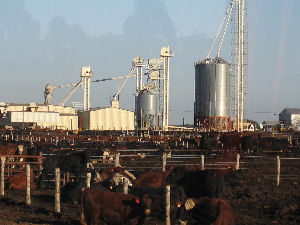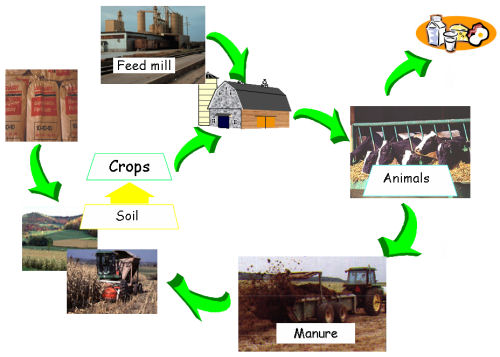How much manure can I apply to this field? is a common question when developing a nutrient management plan for the upcoming year. This type of planning allows a farmer to ensure there is enough crop land available to adequately use manure nutrients, plan for manure storage emptying, or estimate commercial fertilizer needs to take advantage of lower pricing. Manure is a very good source of nutrients for plants and organic matter for soils. These nutrients have significant value if managed properly. This page describes the information needed to make these calculations. While the process may seem complicated, it is not difficult and provides an easy template to follow in future years.
How Many Nutrients Will the Crop Use?
The starting point for determining manure application is to calculate the amount of nutrients, especially nitrogen (N) and phosphorus (P), expected to be used by that year’s crop. To find the values recommended for your area, do a web search for “crop nutrient uptake” or “crop nutrient removal” plus your state’s name. If your search turns up empty, contact your local extension service for assistance. The following pieces of information are usually needed to use your state crop nutrient tables.
- What is the crop to be grown?
- What is the soil type in the field? (Not needed in all states.)
- What is the expected yield for this crop?
A realistic yield can be determined by taking the 5-year average yield for this field and crop and add 10% (some states may recommend a different factor to add) to account for improvements in hybrids and farming techniques. If the 5-year average includes a disaster or exceptionally low yield due to hail, flooding, or similar situation, remove that year from the calculation. The crop nutrient uptake tables for your state will usually provide a factor to calculate nutrient need of the crop based on the expected yield.
Nitrogen Credits from Legumes and Past Manure Application
Organic-nitrogen from past legume crops or past manure applications continues to mineralize into crop-available nitrate-nitrogen for several years. To estimate how much nitrogen will become available from past manure or compost applications, see “Estimating Crop Nutrient Availability of Manure and Other Organic Nutrient Sources“. Legume credits recommended for your state can be found by doing a web search for “legume credit” plus your state name.
What Level of Plant Available Nutrients Are Already Present In the Soil?
In addition to organic-nitrogen that may be already present in soils, there may be plant-available nitrate-nitrogen already present. The best way to determine this is to do a soil nitrate test. To find recommended procedures and labs in your state, do a web search for “soil testing” plus your state name.
Phosphorus and potassium form past manure applications are mostly plant-available right away. If overapplied year after year (as can be the case with a field that receives repeated manure applications) the levels will build up over time. For phosphorus, this is a concern because of the potential for runoff to water. In some states, soils with extremely high phosphorus levels may be off-limits for further manure application (due to the relatively high phosphorus content of manure in comparison to nitrogen). Most states have developed a phosphorus index which is a risk management tool for avoiding fields or situations with greater potential for phosphorus runoff to water. If you are concerned that some of your fields fall into this category, see “What is the P Index?”
How Many Nutrients Are In the Manure?
Manure is highly variable from farm to farm. The nutrient content changes based on how is the manure collected, stored, and treated. It also varies by animal species. When doing pre-season planning, the best indicator of nutrient content in the manure is to look at past manure tests from your own farm. If you are doing your nutrient planning close to the time manure will be land-applied, then sampling manure in your storage will provide good information. As a last resort, planning can be done using “book values” or averages based on research and testing done in your state (do a web search for “manure book values” plus your state name).
It is impossible for plants to use applied nutrients with 100% efficiency, regardless if source is animal manures or commercial fertilizers. Studies have shown that nutrient use efficiency for nitrogen ranges from 30% to 75%, and is dependent on the crop, the specific nutrient, weather, and many other environmental factors. The goal of a nutrient management planner and waste applicator is to obtain the best use of the manure nutrients. This requires intensive management.
Nutrient Management Planning
Nutrient management guidance is typically done at the state level. General guidance may be available at a regional or national level from USDA Natural Resources Conservation Service (NRCS). You can also seek the advice of a local expert who is with the Cooperative Extension Service, land grant institution, state department of agriculture, or the state regulatory agency to obtain manure nutrient generation values relevant to the area, specieds, and system you are working with.
Tables that offer production volumes for manure as well as manure nutrient concentration are available for planning purposes, but should not be used to determine application rates on a daily basis. Frequent manure sampling is the only way to make a good assessment of manure nutrient value. Then, with data that relates to loss potential as it relates to manure application method and timing, one can make good recommendations as to appropriate application rates that assure maximum crop use efficiency and minimize losses.
Author: Karl Shafer, North Carolina State University




